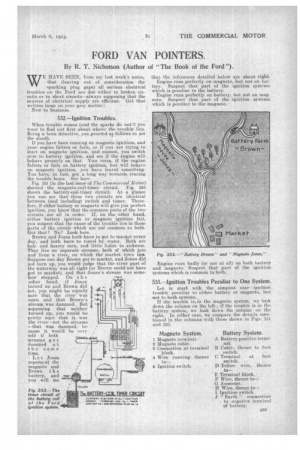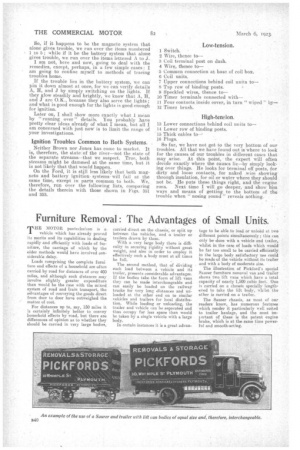FORD VAN POINTERS.
Page 23

Page 24

If you've noticed an error in this article please click here to report it so we can fix it.
By R. T. Nicholson (Author of "The Book of the Ford ").
WE HAVE SEEN, from my last week's notes, that (leaving out of consideration the sparking plug gaps) all serious electrical troubles on the Ford are due either to broken circuits or to short circuits—always supposing that the sources of electrical supply are efficient. Get that
written large on your grey mater! , Now to business.
532.—Ignition Troubles.
When trouble comes (and the sparks do not!) you want to find out first about where the trouble lies. Being a horn detective, you proceed a2 follows to act the sleuth.
If you have been running on magneto ignition, and your engine falters or fails, or if you are trying to start on magnetq ignition, and cannot, you switch over to battery ignition, and see if the engine will behave properly on that. Vice versa, if the engine falters or fails on battery ignition but will behave on magneto ignition, you have learnt something. You have, in fact, got a long way towards tracing the trouble home. See here.
Fig. 351 (in the last issue of. The Commercial Motor) -showed the magneto-coil-timer circuit. Fig. 353 shows the battery-coil-timer circuit. At a glance you can see that those two circuits are identical between (and including) switch and timer. Therefore, if either battery or magneto will give you perfect ignition, you know that the common parts of the two circuits are all in order. If, on the other hand, either battery ignition or magneto ignition fail, you suspect that the cause of the trouble lies in those parts of the circuit which are not common to both. Got that? No? Look here.
Brown and Jones both have to get to market every day, and both have to travel by water. Both arc hale and hearty men, and little liable to sickness. They live on separate streams, both of which join and form a river, on which the market town lies. Suppose one day Brown got to market, and Jones did not turn up, you would judge that the river part of the waterway was all right (or Brown could not have got to market), and that Jones's stream was some
how stopped. On t h o • ER
other hand, • if Jones turned up and Brown did not, you might be equally sure that the river was open and that Brown's stream was dammed. But supposing that neither turned up, you would be pretty sure that it was the river—not the streams —that was dammed, because it would be very odd if both streams g o t dammed at the same time.
Let Jones represent the magneto and Brown the battery, and Kw you will see
that the inferences detailed below are about right. Engine runs perfectly on magneto, but not on battery. Suspect that part of the ignition systems which is peculiar to the battery.
Engine runs perfectly on battery, but not on magneto. Suspect that part of the ignition systems which is peculiar to the magneto.
Engine runs badly (or not at all) on both battery and magneto. Suspect that part of the ignition systems which is common to both.
533.—Ignition Troubles Peculiar to One System.
Let is start with the simplest case—ignition trouble peculiar to either battery or magneto, but not. to both systems.
If the trouble islin the magneto system, we look down the column on the left ; • if the trouble is in the battery system we look down the column on the right. In either case, we compare the details mentioned in the columns with those shown in Figs. 351 and 353.
Magneto System.
1 Magneto terminal.
2 Magneto cable. 3 Connection at terminal block.
4 Wire running thence to
6 Ignition switch.
Battery System.
A Battery positive terminal.
B Cable, thence to foot switch.
C Terminal at foot switch.
D Yellow wire, thence to—
E Terminal block. F Wire, thence to- G Ammeter.
H Wire, thence to—
I Ignition switch.
J " Earth " connection to negative terminal of battery.
So, if it happens to be the magneto system that alone gives trouble, we run over the items numbered 1 to 5; while if it be the battery system that alone gives trouble, we run over the items lettered A to J. I am not, here and now, going to deal with the remedies, except, perhaps, in a few simple eases : I am going to confine myself to methods of tracing troubles home.
If the trouble lies in the battery system, we can pin it down almost at once, for we can verify details A, H, and J by simply switching on the lights. if they glow steadily and brightly, we know that A, H, and J are O.K., because they also serve the lights ; and what is good enough for the lights is good enough for ignition.
Later on I shall show more exactly what I mean by "running over" details. You probably have pretty clear ideas already of what I mean, but all I am concerned with just now is to limit the range of your investigations.
Ignition Troubles Common to Both. Systems.
Neither Brown nor Jones has come to market.. It is, therefore, the state of the river—not the state of the separate streams--that we suspect. True, both streams might be dammed at the same time, but it is not likely that that would happen.
On the Ford, it is still less likely that both magneto and battery ignition, systems • will fail at the same time, except in parts common to both. We, therefore, run over the following lists, comparing the details therein with those shown in Figs. 351 and 353. Low-tension.
1 Switch.
2 Wire, thence to 3 Coil terminal post on dash.
4 \Vim thence to
5 Common connection at base of coil box.
6 Ceil units.
7 Upper connections behind coil units to— S Top row of binding posts.
9 Speckled wires, thence to 10 Timer terminals connected with— ii contacts inside cover, in turn " wiped "
12 Timer brush.
High-tem ion.
13 Lower connections behind coil units to
14 Lower row of binding posts.
15 Thick cables 16 Plugs.
So far, we have not got to the very bottom of our troubles. All that we have found out is where to look for the causes of our troubles in different cases that may arise. At this point., the expert will often decide exactly where the causes lie—by simply looking over things. He looks for terminal off posts, -for dirty and loose contacts, for naked wire showingthrough insulation, for oil or water where they should not be. He puts these things right, and the engine runs. Next time I will go deeper, and show him ways and means of getting to the bottom of the trouble when "nosing round" reveals nothing.




























